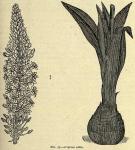 The inner freshly scaled bulb of the white variety Urgin'ea maritima (Linné) Baker, cut into slices and dried.
The inner freshly scaled bulb of the white variety Urgin'ea maritima (Linné) Baker, cut into slices and dried.
BOTANICAL CHARACTERISTICS.—Bulb semisuperficial. Leaves lanceolate, all radical, appearing after the flowers. Scape 2 to 4 feet high, terminated by a dense raceme of yellowish-green flowers, each one of which is accompanied by a long bract; ovary with 3 nectariferous glands at the apex.
HABITS OF PLANT.—Grows in sandy places near the coast. The plant flowers in autumn, the leaves appear in the following spring. Bulb only half immersed in the soil.
HABITAT.—Mediterranean shores, in dry, sandy places near the coast.
DESCRIPTION OF DRUG.—Squill comes into the market in narrow horny segments about 50 mm. (2 in.) long, often more or less contorted; color varying from white or yellowish-white to a reddish tint, slightly translucent; when dry, it is brittle and pulverizable, but by exposure to a moist atmosphere it becomes flexible. Occasionally vertical slices, sometimes adhering at the base, are met with. Odor slight; taste mucilaginous, bitter, nauseous, and acrid.
The fresh bulb is inversely pear-shaped, fleshy, varying in size from that of a man's fist to a child's head. There are two kinds, differing only in color, one being entirely white, and the other reddishbrown externally, internally rose color, with white parenchyma. In preparing f or market the outer scales are removed and the bulb is then sliced transversely, the central scales being also rejected as being too fleshy and mucilaginous; they lose about four-fifths of their weight in drying.
TEST.—If made into the official tincture and assayed biologically, the minimum lethal dose should not be greater than 0.006 mil of tincture or the equivalent in tincture of 0.0000005 Gm. of ouabain, for each gram of body weight of frog.
Powder.—Characteristic elements: See Part iv, Chap. I, B.
CONSTITUENTS.—Merck's analysis shows three active principles, scillipicrin (a bitter principle acting upon the heart), scillitoxin, glucoside (bitter, burning, also acting upon the heart), scillin, crystalline (producing numbness, vomiting, etc.), with mucilage, sugar, sinistrin, C6H10O5, like dextrin, and calcium oxalate crystals. Later investigations point to the probability of the above principles being alkaloids, and they are named scillapicine, scillamarine, and scillamine respectively. Jamersted's scillain is a poisonous glucoside of a yellow color. Ash, not exceeding 8 per cent.
ACTION AND USES.—Expectorant, diuretic, in large doses emetic and cathartic. As an expectorant it is usually combined with tartar emetic or ipecac; as a diuretic, with stimulant expectorants. It is very rarely given as an emetic because of its uncertainty, having often proved fatal from its irritant action on the stomach and intestines, and by causing hypercatharsis, death occurring by arrest of the heart in systole. Dose: 1 to 3 gr. (0.065 to 0.2 Gm.).
- OFFICIAL PREPARATIONS.
- Acetum Scillae (10 per cent.) . . . Dose: 10 to 30 ♏︎ (0.6 to 2 mils).
- Syrupus Scillae (45 per cent. of the acetum), . . . 30 to 60 ♏︎ (2 to 4 mils).
- Fluidextractum Scillae, . . . 1 to 4 ♏︎ (0.065 to 0.25 mil).
- Syrupus Scillae Compositus (fl'ext. 8 per cent., with a fl'ext. senega 8 per cent., and tartar emetic 2 per cent. or 1/8 gr. to the teaspoonful), . . . 15 to 60 ♏︎ (1 to 4 mils); 1 to 2 fl. dr. (4 to 8 mils).

